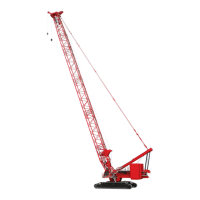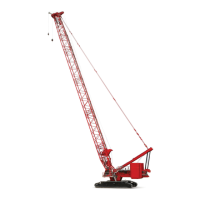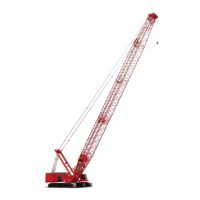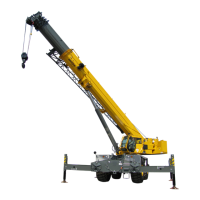Manitowoc Published 04-06-18, Control # 231-14 4-97
MLC650 VPC-MAX™ OPERATOR MANUAL SET-UP AND INSTALLATION
AUXILIARY FRAME OPERATING POSITIONS
See Figure 4-80 for the following procedure.
The auxiliary frame assembly has two operating positions:
WORKING Position (View A):
This is the recommended operating position.
RAISED Position (View B):
This position can be used if additional clearance is
required for swinging over job site obstacles.
Lower the auxiliary frame assembly after the
obstacle is cleared. Continued operation with the
auxiliary frame assembly raised is not
recommended.
To change the operating position, proceed as follows:
NOTE The auxiliary frame assembly weighs approximately
4 286 kg (9,450 lb).
1. Proceed as follows to move the auxiliary frame
assembly to the RAISED position:
a. Attach the SH 2 shackles (1, View A) and the SL 4
slings (2) to the lifting lugs (3) on the auxiliary frame
assembly (4) and to the hook of an assist crane.
b. Hoist just enough to tighten the lifting slings.
c. Remove the hitch pins (5A) from the working
position (View C) and store them (View D).
d. Using the remote control, disengage the powered
retaining pins (5).
e. Lift the auxiliary frame assembly (4, View A) away
from the VPC-MAX beam.
f. Move the alignment pins (6, View A) from the top
holes (A, View A) in the auxiliary frame assembly to
the bottom holes (B, View B) in the auxiliary frame
assembly.
g. Lift the auxiliary frame assembly (4) into position at
the end of the VPC-MAX beam so the alignment
pins (6, View B) engage the notches in the beam.
h. Using the remote control, engage the powered
retaining pins (5) to connect the auxiliary frame
assembly (4) to the VPC-MAX beam.
i. Move the hitch pins (5A) from the stored position
(View d) to the working position (View c) and install
the hair pin cotters (5B).
j. Disconnect the shackles and lifting slings from the
auxiliary frame assembly.
2. Proceed as follows to move the auxiliary frame
assembly to the WORKING position:
a. Attach the SH 2 shackles (1, View B) and the SL 4
lifting slings (2) to the lifting lugs (3) on the auxiliary
frame assembly (4) and to the hook of an assist
crane.
b. Hoist just enough to tighten the lifting slings.
c. Remove the hitch pins (5A) from the working
position (View C) and store them (View D).
d. Using the remote control, disengage the powered
retaining pins (5).
e. Lift the auxiliary frame assembly (4, View A) away
from the VPC-MAX beam.
f. Move the alignment pins (6, View B) from the
bottom holes (B, View B) in the auxiliary frame
assembly to the top holes (A, View A) in the auxiliary
frame assembly.
g. Lift the auxiliary frame assembly (1) into position at
the end of the VPC-MAX beam so the alignment
pins (6, View A) engage the notches in the beam.
h. Using the remote control, engage the powered
retaining pins (5) to connect the auxiliary frame
assembly (4) to the VPC-MAX beam.
i. Move the hitch pins (5A) from the stored position
(View D) to the working position (View C) and install
the hair pin cotters (5B).
j.
Disconnect the shackles and lifting slings from the
auxiliary frame assembly.
WARNING
Structural Damage Hazard!
A sudden release of load and/or dynamic loading (due to
swinging, hoisting, or lowering and adverse weather
conditions to include wind) may cause structural damage
due to shock loading and unintended motion of the crane.
The auxiliary frame assembly is provided to limit
unintended motion of the VPC-MAX beam and
counterweights during a sudden release of load and/or
dynamic loading (due to swinging, hoisting, or lowering
and adverse weather conditions to include wind).
The auxiliary frame assembly in no way substitutes for, or
lessens, the requirement that the crane must be operated
properly and safely, and that it must be inspected,
serviced, and maintained regularly to minimize the
potential for a sudden release of load and/or dynamic
loading (due to swinging, hoisting, or lowering and
adverse weather conditions to include wind).

